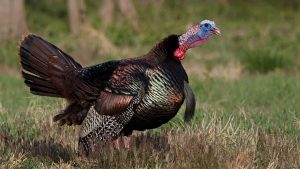Bird of the Week: Wild Turkey
 Listen for the characteristic sound of gobbling and you may be led to a group of male turkeys performing impressive courtship displays. Completely different from the dull looking females, male turkeys have bright, colorful feathers as well as a “beard” of course feathers coming from its chest. The head and neck of a male turkey is colored red, white and blue and can change color with the turkey’s mood. Despite their large size, turkeys can fly up to a mile at a time. They have great eyesight during the day, but their vision is poor at night and they prefer to roost in trees in large numbers to protect from night time predators. While out on our trails you may find signs of wild turkeys. Turkeys use their large feet and sharp claws to dig up roots, tubers and other treats. Keep an eye out for small areas with a scratched or disheveled look. You may also find another classic sign, scat! Due to the inner anatomy of turkeys, you can tell whether the scat belongs to a male or female. Male scat is elongated and J-shaped while the female scat is spiral shaped, like a snail shell.
Listen for the characteristic sound of gobbling and you may be led to a group of male turkeys performing impressive courtship displays. Completely different from the dull looking females, male turkeys have bright, colorful feathers as well as a “beard” of course feathers coming from its chest. The head and neck of a male turkey is colored red, white and blue and can change color with the turkey’s mood. Despite their large size, turkeys can fly up to a mile at a time. They have great eyesight during the day, but their vision is poor at night and they prefer to roost in trees in large numbers to protect from night time predators. While out on our trails you may find signs of wild turkeys. Turkeys use their large feet and sharp claws to dig up roots, tubers and other treats. Keep an eye out for small areas with a scratched or disheveled look. You may also find another classic sign, scat! Due to the inner anatomy of turkeys, you can tell whether the scat belongs to a male or female. Male scat is elongated and J-shaped while the female scat is spiral shaped, like a snail shell.
